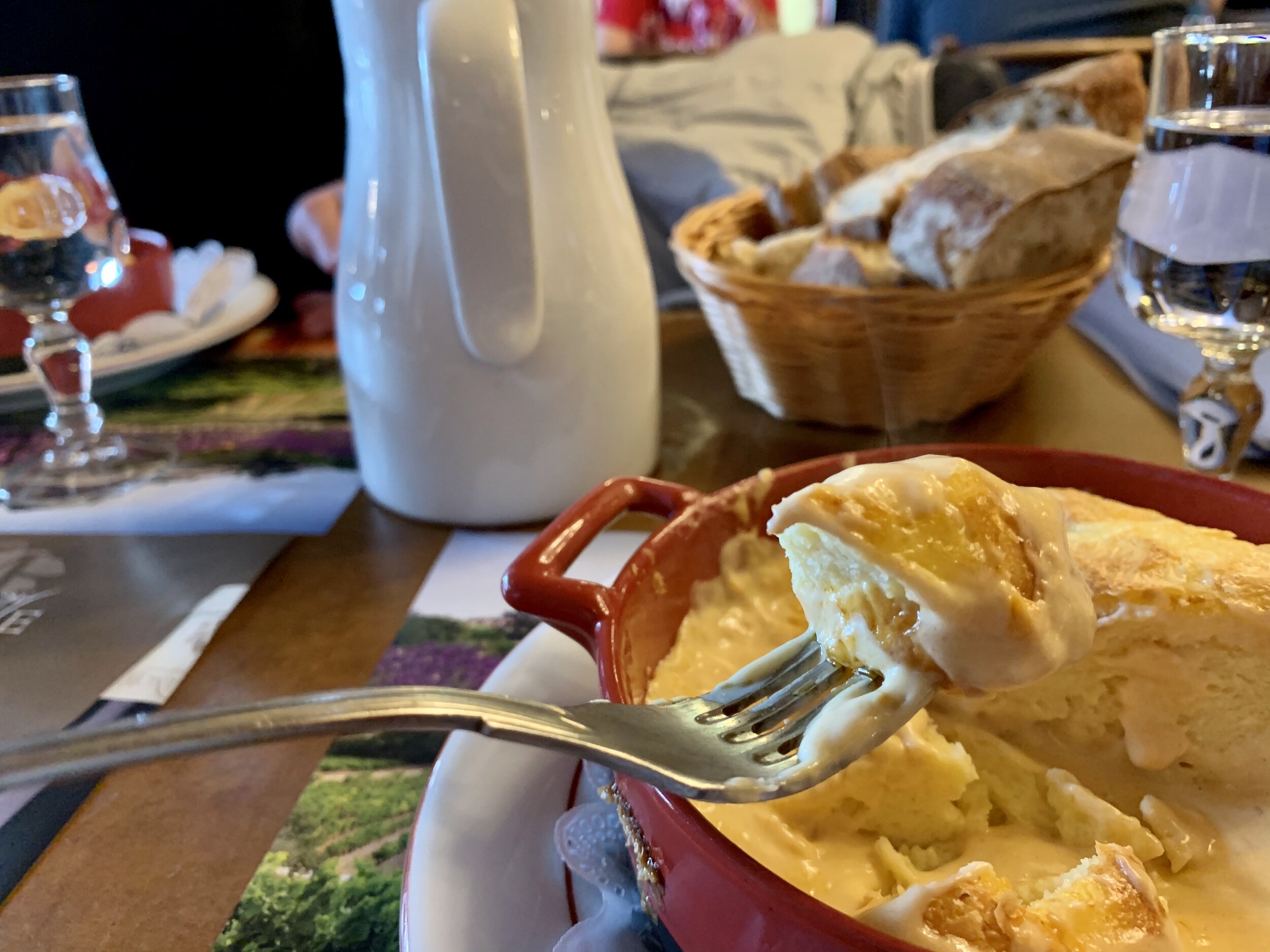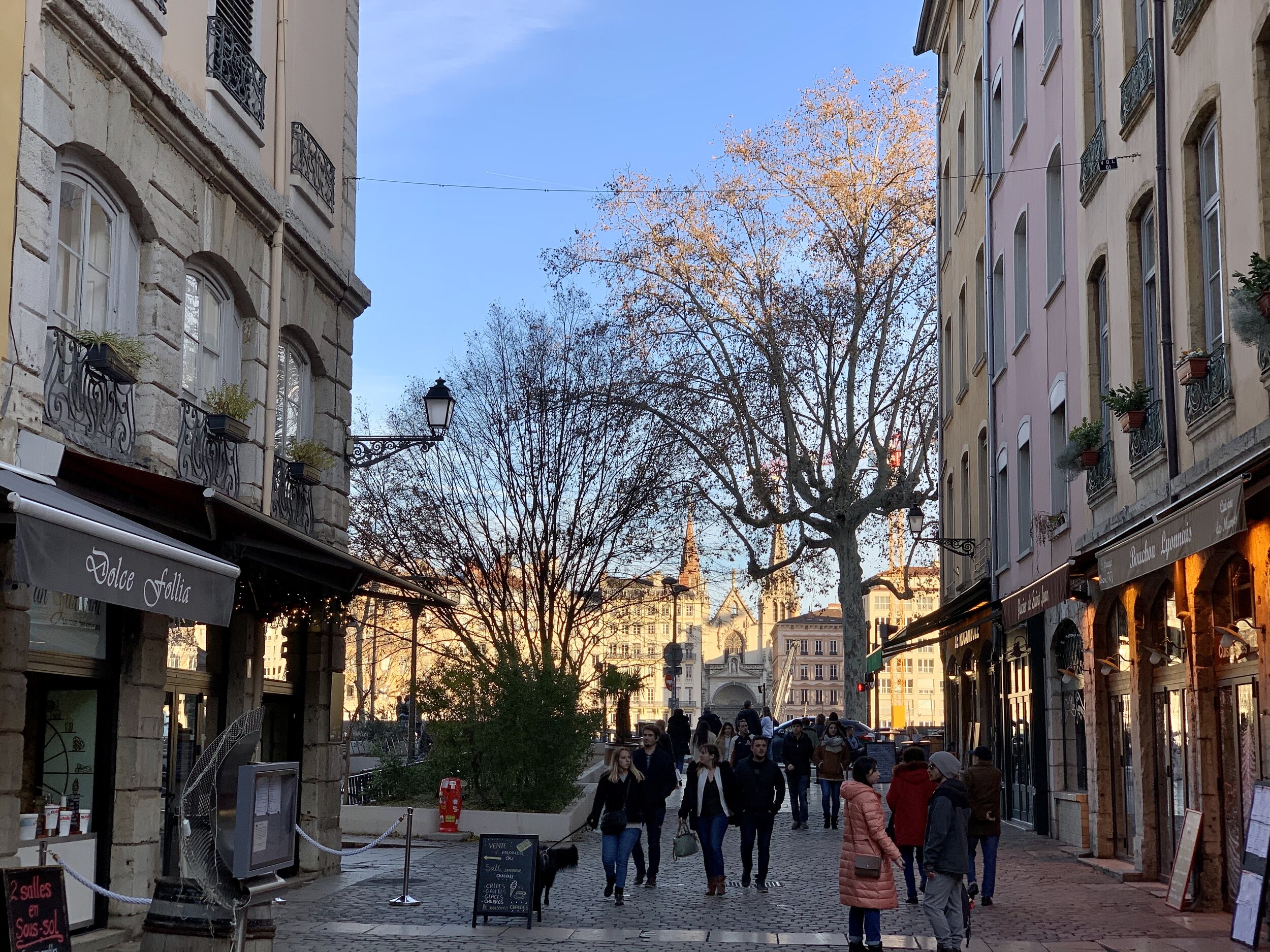A Long Weekend of Food and Walking Tours in Lyon
Sampling the iconic Lyonnaise quenelle on a walking food tour of the city. Lyon, France. December 15, 2019.
Given that we had only a few days for my birthday weekend, I wanted to find somewhere close enough to Lausanne to reduce transit time.
This limited my horizons to Europe. (Not a bad limit, I’ll admit.) However, as winter trends toward the cold, wet, and dark in most of Europe, areas that focus on landscapes and relaxing in the great outdoors don’t appeal at birthday time.
Granted, if I’d liked skiing and winter sports more, several parts of Switzerland could have worked—though most of the major areas wouldn’t have had much snow yet by mid-December. (So maybe not.) Yet even if I did enjoy winter sports, I’d have to utterly adore them to fork over the prices charged by Swiss hotels in resort areas during the high season.
So I figured a city with cultural activities would at least keep my brain occupied. Paris will always provide an enticing option for a city break from Lausanne, yet I’d never visited Lyon. Our French guidebook didn’t make it sound terribly enticing, but a visit to the Lyon tourism website won me over. (The Lyon tourist office’s website is the best I’ve seen of its ilk.)
Walking tours galore, food tours galore, museums everywhere, and promises of medieval and Renaissance delights. (And I love those.) How could I refuse?
When in Lyon, Eat the Food
When you go to a place called the gastronomic capital of its region or country (whether veritable or otherwise), you must eat.
Side note: I’ve also written an ever-updated post with my go-to destinations in Lyon for snacks, treats, and meals beyond the traditional Lyonnaise gastronomic experience.
However, one issue with having a birthday in the height of the holiday-party season is that you can rarely-to-never find a favorite or desired restaurant available. We managed to get a table at the Croix-Rousse location of Daniel & Denise on one evening and a reservation at Têtedoie for the other evening.
The Lyonnaise call their cozy steakhouse-style restaurants “boucherons.” Daniel & Denise checked the boucheron box for us on this Lyon stay. We started with a plate of charcuterie; followed it with rich main courses of meat and sauce; shared sides of fried potatoes, gratin pasta, and grilled haricots verts; and rounded it all off with desserts of madeleines with chocolate cream (for me) and and île flottante (for Arnaud).
Têtedoie had the antiseptic and bland feel of a hotel restaurant. Though unquestionably elegant and with a panoramic view from atop a hill down onto Lyon, the food didn’t quite match the standards of some of the other fine dining experiences we’ve had in France. Without question, Tetedoie counts as haute cuisine—yet its tasting menu didn’t surprise us with flavors or inventiveness.
In addition to our dinners, we took a food tour on foot to get a taste of each of Lyon’s celebrated specialties. Our guide had carefully curated spots across the center of the city for us to experience:
Saint-Marcellin and cervelle de Canut cheeses from La Cremerie Saint-Antoine
Lyon’s iconic red pralines (almonds enrobed in red-colored sugar), praline syrup (invented by the proprietor), rosette (a dry pork sausage), Voisin Papillotes (chocolates wrapped with old-time Lyonnaise riddles and dad jokes), and snacks galore from Le Sirop de la Rue
Brioche aux pralines, a bread studded with Lyonnaise pralines, from La Boulangerie du Palais
Pike quenelles, a type of dumpling that mashes up pike in the dough, enrobed in a creamy, fishy sauce
Local honeys from Secrets d’Apiculteur
Also, the tour treated us to a couple of coussin de Lyon from Voisin, little green pillow-shaped candies made from marzipan and chocolate. (Given their pop of sugary sweetness, you only need one!)
Lyon Walking Tours
I adore walking tours, on which I got hooked when I lived in London decades ago. I used to do at least one a month as a way to explore the city and learn more about its history. All the walking tour opportunities listed on the Lyon tourist office’s website lured my interest and made visiting this somewhat-unheralded city much more enticing.
An expertly guided walking tour can provide an understanding of a location and its history within its geography and setting. History museums pale in comparison, no matter how interactive their exhibits. (For more on how to find a good walking tour, read my article with walking-tour tips.)
Sure, you can attempt to follow maps and guidebooks and give yourself a walking tour—and when good guides aren’t available, this may be your only option—but this sticks you with juggling and staring down at paper and books and piecing together details, rather than absorbing spaces and stories. (Also, few things scream “rob this lost tourist” than starting at guidebooks and maps.)
In addition to the food-focused walking tour, we did a nighttime walking tour through the central parts of Lyon to hear about its legends and mysteries—all towns with history stretching back before the Roman era have unsolved stories and longstanding superstitions—did a tour of the Croix-Rousse neighborhood to learn a bit more about its architecture and history, took a tour of the Presqu’île neighborhood for the same, and did a general-city walking tour for some of the overarching background on Lyon.
I told you: We did a lot of walking tours.
A few quick historical highlights: Lyon’s recorded history starts in the Roman era (and its unrecorded history starts well beforehand); the city has several extant Roman ruins on view. During the Renaissance and on through the industrial revolution, Lyon became famous for its silk production and trade. The city still has the industrial feel of a working town even today, though the silk trade has long since moved to other parts of the world.
Given the season, the tourist office didn’t offer many English-language tour options, despite promising several during the high season. (Here we go again with my French-language barrier.)
The only tourist-office tour that fit our schedule was the general-overview one. I don’t feel that we got the best guide (at least, not based on my walking-tour experiences), and a little follow-up research revealed a few information inaccuracies. Further, he missed a lot of possible storytelling opportunities, favoring pauses to point out buildings and architectural details with minimal historical context, rather than describing how what we saw fit into the city’s history, culture, and trajectory. (Our guide of the Croix-Rousse neighborhood did the same.)
Other than the general-overview tour, we booked all walking tours through AirBNB, to mixed results. We truly enjoyed the food tour, which our guide had well crafted, and we enjoyed the two tours we took with a guide called Nicholas who has a company with his sister called Vivre à la Lyonnaise. If you visit Lyon and like walking tours, I highly recommend them.
Lyon Neighborhoods: Where to Stay
All these walking tours took us through most of Lyon’s central neighborhoods, which gave us a feel for where we’d like to stay when we go back.
For this trip, we stayed in La Croix-Rousse, a now-hipster neighborhood that housed a lot of the silk workers and their workshops during the Industrial Revolution. La Croix-Rousse had absolutely everything we could have wanted in terms of amenities: bakeries, groceries, quick-food options, and even nice restaurants and boutiques.
However, the neighborhood required more of a hike to and from the central areas of town than we prefer for city stays. If we wanted to return to our perch between activities, we had to walk about three miles roundtrip. Though I can’t complain about the exercise—which I needed after all the food, even given the walking tours—it meant that we didn’t make the most of having access to a full kitchen in our AirBNB rental or have much by way of relaxing downtime.
When we head back to Lyon, we will look for hotels or apartments in the Unesco-listed old town, Vieux Lyon, or in the middle-of-it-all Presqu’île neighborhood.
Don’t Overlook Lyon
I went into the Lyon trip planning to glut myself with food and walking tours—give me all the walking tours, I said—and so, though I wished we’d had better guides for some of the tours, I didn’t feel walking-toured out by the end of the long weekend. Arnaud went along with my birthday wishes, though he said he could have done with just one or two talking tours in total and a few more museums.
In truth, with all the walking tours, we didn’t have the opportunity to do much of the city in depth. However, we had only a weekend; even if we’d done other types of activities, we wouldn’t have truly plumbed Lyon. The walking tours gave us a good feel for the neighborhoods in which we’d like to stay and the museums and activities we’d like to try next time.
And there will be a next time, and relatively soon: Though we purchased Lyon City Cards in advance of our trip, we didn’t end up using them. With all the walking tours, we didn’t have time to visit museums and didn’t need the public transportation. The good news: The cards last for a year and the days purchased commence only upon a card’s first use. This means we have a solid excuse to return and explore further within the next several months.
How does Lyon compare to the other large cities in France? It doesn’t have the sultry Mediterranean feel of Marseilles—including the golden sunshine—and it doesn’t have the romantic artistry of Paris—replete with its sense of intellectualism and dissipation—yet it has its own gritty, working-class beauty.














